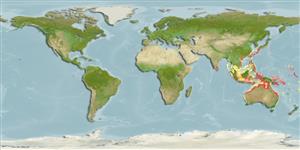>
Carangaria/misc (Various families in series Carangaria) >
Leptobramidae (Beachsalmon)
Etymology: Leptobrama: Greek, leptos = thin + old French breme, bresme, a fresh water fish; 1460 (Ref. 45335).
More on author: Steindachner.
Environment: milieu / climate zone / depth range / distribution range
экология
морской; пресноводный; солоноватоводный пелагический. Tropical
Indo-West Pacific: northern Australia.
Size / Вес / Возраст
Maturity: Lm ? range ? - ? cm
Max length : 37.5 cm SL самец/пол неопределен; (Ref. 30691)
Краткое описание
морфология | морфометрия
позвонки: 24. This species is distinguished by the following set of characters: head length 21.7-22.7 % SL, snout length 19.9-24.5 % HL, upper jaw length 53.0-61.3 % HL, snout length 35.6-43.4% of upper jaw length; total gill rakers 13-18; scale rows below lateral line 13-14; vomerine tooth patch is rhomboid; tip of pectoral fin is almost same level as tip of appressed pelvic fin; lateral line gradually curved anteriorly. Colouration: a prominent black spot distally on anterior dorsal fin, with its size almost same as eye diameter or larger (Ref. 129587).
This species is apparently living inshore and migrating into brackish water as the specimens used in this study were collected from the lower reaches of rivers, estuaries or inner part of bays (Ref. 129587).
Life cycle and mating behavior
половая зрелость | размножение | нерест | икра | Fecundity | личинки
Kimura, S., T. Peristiwady and R. Fricke, 2016. Taxonomic review of the genus Leptobrama Steindachner 1878 (Perciformes: Leptobramidae), with the resurrection of Leptobrama pectoralis (Ramsay and Ogilby 1887). Ichthyol. Res. 63:435-444. (Ref. 129587)
Статус Красного Списка МСОП (Ref. 130435)
Угроза для людей
Harmless
Использование человеком
дополнительная информация
народные названиясинонимыобмен веществхищникиэкотоксикологияразмножениеполовая зрелостьнерестSpawning aggregationFecundityикраРазвитие икры
Возраст/РазмерыростЗависимость между длиной и массой телаЗависимость между длинамиРазмерный составморфометрияморфологияличинкидинамика численности личинокпополнениечисленностьBRUVS
ссылкиаквакультура (рыбоводство)особенности рыбоводствастепень растяжениягенетикаElectrophoresesнаследуемостьболезниобработкаNutrientsMass conversion
соавторыизображенияStamps, Coins Misc.звукиCiguateraскоростьтип плаванияжаберная областьOtolithsмозгзрение
инструменты
Специальные отчеты
Скачать в формате XML
ресурсы в Интернет
Estimates based on models
Preferred temperature (Ref.
123201): 24.1 - 28.9, mean 27.7 °C (based on 544 cells).
Phylogenetic diversity index (Ref.
82804): PD
50 = 1.5000 [Uniqueness, from 0.5 = low to 2.0 = high].
Bayesian length-weight: a=0.01122 (0.00514 - 0.02450), b=3.04 (2.87 - 3.21), in cm total length, based on all LWR estimates for this body shape (Ref.
93245).
Trophic level (Ref.
69278): 4.5 ±0.8 se; based on diet studies.
Fishing Vulnerability (Ref.
59153): Moderate vulnerability (36 of 100).
